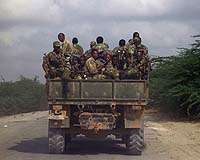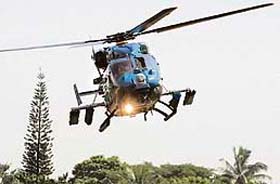Somalia A Lawless Country
(NSI News Source Info) November 8, 2008: A growing number of countries are demanding that "something be done" about Somalia. The country has become a base for an increasing number of criminal operations. In the north there are the pirates, who are earning several million dollars a month by seizing ships passing through the Gulf of Aden. The ship owners simply tolerate higher insurance rates to pay for the ransoms and "danger pay" for the crews. Meanwhile, the men running those ships keep developing new tactics to avoid the pirates. A year ago, about half the pirate attacks would result in a captured ship. Now only about twenty percent of the attacks succeed, and that percentage keeps going down. But the growing number of newly wealthy pirates in Puntland (where most of the pirates are based) are attracting more Somalis to piracy. The two dozen or so foreign warships off the coast are no real problem. The pirates know that the warships will not attack them unless there is an actual attack on a merchant ship in progress. Otherwise, international Human Rights agreements protect the pirates from capture or punishment. This also prevents the warships from attacking pirate bases, either from the sea or by coming ashore.
 Members of the Somali Islamic militia block a road after clashes with a self-styled coalition of warlords
Members of the Somali Islamic militia block a road after clashes with a self-styled coalition of warlords
Down south, the better organized, and motivated, Islamic radicals take control of more towns. These militias are only a minority of the armed groups that exist throughout the country. The non-religious warlords (mainly the Transitional National Government, or TNG) are unable to unite sufficiently to suppress the religious groups (the Alliance for the Re-liberation of Somalia, or ARS, which is the successor to the Islamic Courts Union, or ICU). Kenya and Ethiopia find their borders crossed more frequently by Somali raiders (something which has been going on for centuries), and are seeking Western nations that will help contain Somali aggression. So far, the only people seriously listening are those with counter-terrorism forces (mainly American, British and French) in Djibouti (Somalia's neighbor in the north.) But this force of commandos keeps its operations very secret. Apparently, this Djibouti based force monitors what goes on in Somalia, and occasionally intervenes to kill key al Qaeda operatives. There are more al Qaeda showing up in Somalia, and apparently they are leading a terror campaign against relatively peaceful warlords controlling most of northern Somalia (Puntland and Somaliland). The newly arrived terrorists are finding that Somalia is a very hostile environment. Over a third of the population faces starvation, and most Somalis depend, in whole or part, on food aid brought in by foreign aid groups. But many warlords make money by extorting or stealing from the foreign aid organizations. As a result, no matter how much food is brought in, some Somalis are not getting enough to prevent starvation deaths. Again, no foreign country is willing to go in and deal with this situation. That's because it's recognized that it would take a colonial type government to bring peace to Somalia, as most Somalis have shown, over the last two decades, that they cannot govern themselves. Since colonialism is very politically incorrect, the situation will have to get a lot worse before the world community will do anything decisive to shut down the horror show that has developed in Somalia.
The bodies of at least 60 Somalis and Ethiopians washed up on Yemeni beaches. Smugglers apparently pushed their passengers overboard too far off shore. It is believed that 1-2 percent of the nearly 4,000 illegal migrants crossing the Gulf of Aden each month, die this way. The smugglers don't like letting their passengers off too close to the shore, as that risks being spotted and captured by the Yemeni coast guard. At the very least, the smugglers could lose their boats. However, sometimes the smugglers demand more money (the usual fee for getting smuggled across the Gulf of Aden is about $100), and push those who will not, or cannot, pay off the boat while still far offshore. There appear to be about 20 percent more people trying to sneak into Yemen from Somalia this year than last.
November 5, 2008: Six foreign aid workers (two Kenyans and four Europeans) were kidnapped in the north (580 kilometers north of Mogadishu).
October 30, 2008: Off the north coast, pirates captured a Turkish ship, carrying iron ore from Canada to China, and its crew of 20. At least five other ships escaped similar attacks. In the southern town of Baidoa, someone threw a grenade into a market place, killing three people. This may have been part of an extortion attempt.
 Israel Copter Pilots Equipped With Night Vision
Israel Copter Pilots Equipped With Night Vision




























